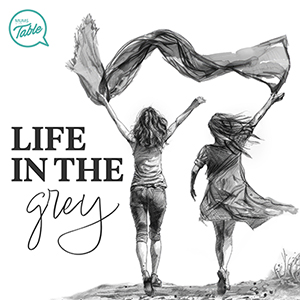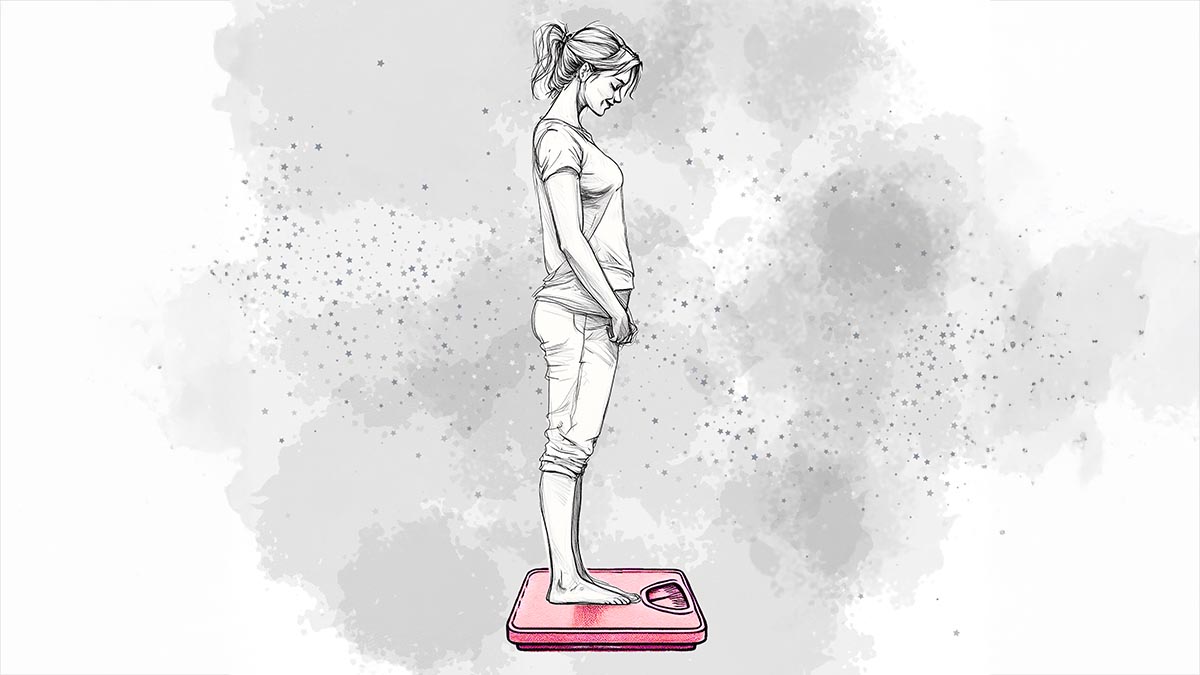For most of my life, I struggled with my body. It wasn’t just about how I looked—it was about what I believed my body said about me: That I was undisciplined; that I lacked willpower; that I needed to be fixed.
I lived in a world where my body size felt like a moral failing; where my weight determined my worth. I internalised the idea that if I could just get it right—if I could be smaller, fitter, more “acceptable”—then I would finally be happy, finally be loved, finally be enough.
But as I’ve come to learn, the pursuit of an “ideal body” isn’t just about health. It’s about the messages we’ve absorbed over the years, the ones that tell us our value is tied to how closely we fit an external standard.
This is my journey from disliking my body to something better: A place where I could exist in my skin without shame. A place where I could honour my body, not as a project to fix, but as something that simply is.
The lies I believed about my body
I didn’t wake up one day hating my body. These thoughts were planted early, reinforced over time and hard to shake.
“Being fat means I lack discipline.”
If I was bigger than I should be, it must be because I wasn’t trying hard enough. That I just needed more willpower. The truth? Health isn’t just about discipline. It’s also about access, education, genetics and mental wellbeing.
“If I reach my goal weight, I will finally be happy.”
I bought into the “arrival myth”: that once I hit a certain number on the scale, everything else in my life would fall into place. But losing weight never magically solved my problems. In fact, it often made things worse because the sacrifices I made to get there weren’t sustainable.
“If I stop trying to shrink, I’m giving up.”
It took years to unlearn the idea that not dieting or not pushing my body to the limit was a form of failure. The reality? Letting go of harmful habits isn’t giving up, it’s choosing a different way to care for myself.
Where the faulty beliefs came from
So many of our body image struggles don’t start with us. They come from the culture we’re raised in, the things we overhear, and the way people around us treat weight and food.
For me, it was a combination of things:
Childhood bullying
My Chinese name sounded close enough to the Chinese word for fat that the kids twisted it into a mockery. Being called fat wasn’t just a description. It was something to be ashamed of. It was a label that could strip away my dignity.
Family expectations
In my family, how we looked, how we behaved and how others perceived us was under constant scrutiny. Not getting fat was one of those unspoken rules. I internalised the message that gaining weight was bad, that people would judge me for it and that controlling my body size was a sign of self-respect.
Rigid health messaging
I was part of a community that believed you were either following the “right” health principles or you were unhealthy. You are either all in or you are failing. There was little room for nuance and even less for self-compassion. Outward appearances were seen as reflections of inward character. The more closely someone followed the “ideal” health principles, the more devoted they seemed. The more they strayed, the more they were viewed as lacking self-control or discipline. It created an unspoken pressure—not just to be healthy, but to present health in a very specific way.
The moralisation of body size
There’s a common narrative that fatness is the result of laziness, poor choices or lack of discipline. But is the problem really will or is it skill? We never blame thin, unfit people for being undisciplined, so why do we assume that being in a bigger body means someone isn’t taking care of themselves?
How my body image affected my actions
All of my faulty beliefs shaped how I saw myself. And for years, I didn’t question them. Looking back, I can see how deeply these beliefs affected my life:
Disordered eating
I tried extreme dieting. I once read that the actor Lea Salonga ate only an apple a day to prepare for Miss Saigon, so I did the same for two weeks. I would go from restricting food to bingeing when I inevitably “failed”.
Exercise as punishment
I didn’t move my body because I enjoyed it, I did it because I had to. Because I needed to earn my food. Because I believed I was only as good as my last workout. And if I skipped a session? It was proof that I was weak, undisciplined and hopeless.
All-or-nothing thinking
If I couldn’t be perfect, why bother? If I missed one workout, I may as well give up completely. If I ate one “bad” meal, I might as well eat five. There was no middle ground.
The shift: From body hate to body neutrality
There wasn’t a single lightbulb moment that changed everything for me. It was a slow process, a series of realisations, therapy sessions and conscious decisions to see things differently.
Some of the key shifts included:
Thanking my body
Instead of criticising my reflection, I started acknowledging what my body does for me. Behind my jiggly belly is a core that holds me upright, stabilising me through every movement. My arms let me hold the people I love. My heart beats without me asking it to. I started seeing my body as something that supports me, moves with me and carries me through life—exactly as it is.
Buying clothes for now
Clothing sizes are wildly inconsistent, even within the same brand. The fashion industry isn’t using some universal rulebook for sizing; it’s a mess of arbitrary numbers that don’t define you. So why should I make my self-worth dependent on something so unreliable?
If I try on a pair of sneakers and they don’t fit, I don’t berate my feet for being the wrong shape, I just ask for a different size. I wouldn’t call my feet “lazy” or “undisciplined” for not squeezing into a shoe that wasn’t made for them. So why would I shame my body for not fitting into a specific pair of jeans?
Feeling good in what I wear isn’t a reward for shrinking myself. It’s something I deserve, exactly as I am.
Curating my social media
One of the biggest shifts I made was in how I consumed information. I actively curated my social media feeds to reflect the values I wanted to internalise—following research-based, science-backed content creators who approach health and movement from a place of inclusivity, not shame. I sought out voices that affirmed that all bodies, regardless of size, deserve dignity and respect.
I stopped engaging with content that pushed the idea that “health” was only valid when it resulted in weight loss or a specific aesthetic. Instead, I followed fitness professionals who didn’t hide their cellulite or worry about their belly rolls while demonstrating proper form.
Listen to Melody and I share how we manage our body image issues on the Mums At The Table podcast, Life in the Grey.
Tracking non-aesthetic progress
I started focusing on what my body can do instead of what it looks like. Can I walk for longer? Can I carry more groceries? Have more energy? Those became my new markers of success.
One of the biggest lies we’ve been sold is that being fit means looking a certain way. That having visible abs, a lean frame or a certain body shape automatically means someone is in peak physical condition. But fitness is measurable. Looks are subjective.
Fitness can be tested: How strong you are, how fast you recover, your endurance, mobility, flexibility, heart rate variability. These things don’t depend on a specific body shape or size. Someone in a larger body can be stronger, faster and more resilient than someone in a smaller one. Meanwhile, someone who looks lean or toned might struggle with stamina, mobility or overall health. Body size alone doesn’t tell the full story.
Once I realised that fitness is what my body can do, not how it looks, I started shifting my focus. I stopped working out to “fix” myself and started moving because I valued my body’s ability to function.
Letting go of the arrival myth
I stopped chasing a finish line that didn’t exist. My worth isn’t waiting for me at a certain weight and my happiness isn’t tied to a number. The arrival fallacy—the idea that happiness and success only come after we reach a certain goal—was a lie around which I built my self-worth.
Here’s the problem that comes with it: The sacrifices I made to get there were sacrifices I had to keep making forever. If I had to give up cake to get thin, once I was thin, I would have to keep giving up cake. And that is a miserable life.
Making room for discomfort
When I say I love my body, it doesn’t mean liking all of my body, all of the time. It means making space for the uncomfortable feelings without letting them dictate my actions. Some days, there are parts of my body that I don’t like. But I don’t hate it either. It’s just mine. And that’s enough.
Where I am now
I won’t pretend that I have everything figured out. There are still days when old thoughts creep in, when I feel the urge to measure my worth by my body size. But now, I have the tools to deal with them.
Healing my body image wasn’t about forcing myself to love my reflection, it was about learning to coexist with my body, without shame, without punishment.
For me, a healthy body image means making space for discomfort while choosing to treat myself with kindness anyway. It means recognising that my body is the least interesting thing about me—it doesn’t define me.
And if that’s where you are too, if you’re struggling to like yourself, to trust yourself, to make peace with your body, know this: You are worthy. You are enough. And you do not need to be smaller, have a flatter stomach, have a thigh gap or whatever other beauty standards are made up these days, to take up space in this world.
You already belong. Just as you are.
Tune in to the Life in the Grey podcast

Life isn’t always black and white. Life in the Grey is a Mums At The Table podcast where we explore the psychological factors that shape our relationships, be that as a parent, a partner or a peer. And don’t worry—it’s short because we ain’t got time for fluff. Expect practical takeaways that you can apply to your own life, whether it’s navigating parenting challenges or finding balance amidst life’s demands. Join us each month as we share stories, insights and reflections that encourage personal growth and foster a sense of connection in our community.
How helpful was this article?
Click on a star to rate it!
5 / 5. 3
Be the first to rate this post!
Faith Toh
Related posts
Subscribe
Receive personalised articles from experts and wellness inspiration weekly!

